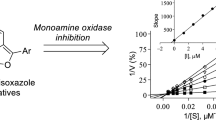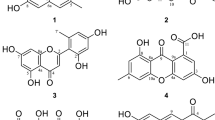Abstract
Thirty kinds of medicinal plants were screened to examine inhibitory activities on rat brain monoamine oxidase A, using serotonin as a substrate. As active principles, various kinds of stilbenes were isolated from Veratri Rhizoma, Reynoutriae Radix and Rhei undulati Rhizoma, and several kinds of flavonoids from Sophorac Flos, Chrisanthemi Flos andGlycine max. Among the compounds isolated, resveratrol(I) strongly inhibited MAO-A competitively, and its IC50 and Ki values were 2 μM and 2.5 μM, respectively. Inhibitory potencies towards MAO-A of some stilbenes and flavonoids were also compared.
Similar content being viewed by others
Literature Cited
Neff, N.H. and Yang, H.-Y.: Another look at the monoamine oxidases and the monoamine oxidase inhibitor drugs.Life Sci. 14, 2061 (1974).
Fowler, C.J., Callingham, B.A., Mantle, T.J. and Tipton, K.F.: Monoamine oxidase A and B: a useful concept.Biochem. Pharmac. 27, 97 (1978).
Cawthon, R.M., Pintar, J.E., Haseltine, F.P. and Breakefield, X.O.: Differences in structure of A and B forms of human monoamine oxidase.J. Neurochem. 37, 363 (1981).
Ban, T.A.:Psychopharmacology, Williams & Wilkins, Baltimore (1969).
Quitin, F., Rifkin, A. and Klein, D.F.: Monoamine oxidase inhibitors: a review of antidepressant effectiveness.Archs Gen. Psychiat. 36, 749 (1979).
Riederer, P., Reynolds, G.P., Jellinger, K., Seemann, D. and Danielczyk, W.: Tranylcypromine isomers in Parkinson's disease. Effect of low doses on monoamine oxidase inhibition and blood pressure response.Modern Problems of Pharmacopsychiatry. Vol.19 Monoamine oxidase and its selective inhibitors. S. Karger, p. 154 (1983).
Birkmayer, W., Knoll, J., Riederer, P. and Youdim, M.B.H.: (−)-Deprenyl leads to prolongation of L-dopa efficacy in Parkinson's disease.ibid, p. 170 (1983).
Stern, G.M., Lees, A.J., Hardie, R. and Sandler, M.: Clinical and pharmacological aspects of (−)-deprenyl treatment in Parkinson's diseases.ibid, p. 231 (1983).
Rigal, F. and Zarifian, E.: MAO inhibitors in psychiatric therapy: effects and side effects.ibid, p. 162 (1983).
Lipper, S., Murphy, D.L., Slater, S. and Buchsbaum, M.S.: Comparative behavioral effects of clorgyline and pargyline in man: a preliminary evaluation.Psychopharmacology.62, 123 (1979).
Han, Y.N., Noh, D.B. and Han, D.S.: Studies on the Monoamine oxidase inhibitors of medicinal plants I. Isolation of MAO-B inhibitors fromChrysanthemum indicum.Arch. Pharm. Res. 10, 132 (1987).
Zeller, E.A.: Oxidation of amines, in Sumner, J.B., Myrbäck (eds.),The Enzymes 1st ed. Vol II. Academic Press. New York, p 536 (1951).
Ichiyama, A., Nakamura, S., Nishizuka, Y. and Hayaishi, O.: Enzymatic studies on the biosynthesis of serotonin in mammalian brain.J. Biol. Chem. 254, 1699 (1970).
Desphande, V.H., Srinivasan, R. and Rao, A.V.R.:Indian J. Chem. 13, 453 (1975).
Hata, K., Kozawa, M. and Baba, K.: A new stilbene glucoside from Chinese crude drug “Heshouwu”, the roots ofPolygonum multiflorum.Yakugaku Zassi 95, 211 (1975).
Nonomura, S., Kanagawa, H. and Makimoto, A.: Chemical constituents of Polygonaceous plants I.Yakugaku Zassi 83, 988 (1963).
Bachelor, F.W., Loman, A.A. and Snowdon, L.R.: Synthesis of pinosylvin and related heartwood stilbenes.Canadian J. Chem. 48, 554 (1970).
Drewes, S.E. and Fletcher, I.P.: Polyhydroxystilbenes from the heartwood ofSchotia brachypetala.J. Chem. Soc. Perkin 1. 961 (1974).
Takaoka, M.:J. Fac. Sci. Hokkaido Univ. 3, 1 (1940).
Kubo, M., Kimura, Y., Shin, H., Haneda, T., Tani, T. and Namba, K.: Studies on the antifungal substance of crude drug(II), on the root ofPolygonum cuspidatum (Polygonaceae).Shoyakugaku Zasshi.35, 58 (1981).
Encyclopaedia Chimica3, 391A, Japan (1980).
Yamazaki, M., Satoh, Y., Maebayashi, Y. and Horie, Y.: Monoamine oxidase inhibitors from a fungus,Emericella navahoensis.Chem. Pharm. Bull. 36, 670 (1988).
Han, Y.N., Ryu, S.Y., Chung, M.S. and Han, B.H.: Aromatic L-amino acid decarboxylase inhibitors from medicinal plants.Arch. Pharm. Res. 11, in press (1988).
Author information
Authors and Affiliations
Rights and permissions
About this article
Cite this article
Ryu, S.Y., Han, Y.N. & Han, B.H. Monoamine oxidase-A inhibitors from medicinal plants. Arch. Pharm. Res. 11, 230–239 (1988). https://doi.org/10.1007/BF02861314
Received:
Issue Date:
DOI: https://doi.org/10.1007/BF02861314




